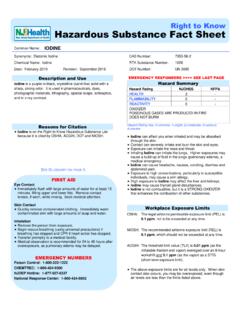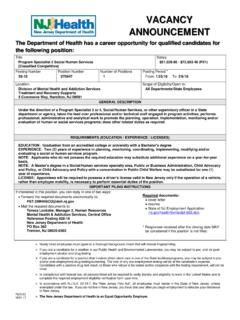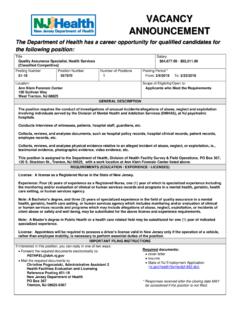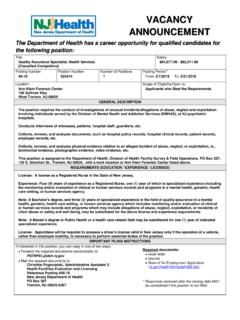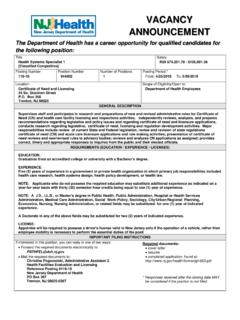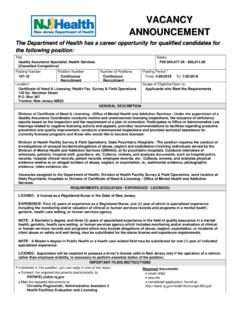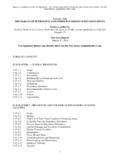Transcription of Right to Know Hazardous Substance Fact Sheet
1 Right to Know Hazardous Substance Fact Sheet Common Name: PETROLEUM DISTILLATES Synonyms: Crude Oil; Petroleum Oil Chemical Name: Petroleum Date: August 2011 CAS Number: 8002-05-9 RTK Substance Number: 2648 DOT Number: UN 1268 Description and Use Petroleum Distillates are dark yellow to brown or green-black liquids with a mild gasoline or kerosene-like odor. They are a complex blend of Hydrocarbons used in making petroleum products. Reasons for Citation f Petroleum Distillates are on the Right to Know Hazardous Substance List because they are cited by OSHA, DOT, NIOSH and IARC.
2 F This chemical is on the Special Health Hazard Substance List. SEE GLOSSARY ON PAGE 5. FIRST AID Eye Contact f Immediately flush with large amounts of water for at least 15 minutes, lifting upper and lower lids. Remove contact lenses, if worn, while rinsing. Skin Contact f Quickly remove contaminated clothing. Immediately wash contaminated skin with large amounts of soap and water. Inhalation f Remove the person from exposure. f Begin rescue breathing (using universal precautions) if breathing has stopped and CPR if heart action has stopped.
3 F Transfer promptly to a medical facility. EMERGENCY NUMBERS Poison Control: 1-800-222-1222 CHEMTREC: 1-800-424-9300 NJDEP Hotline: 1-877-927-6337 National Response Center: 1-800-424-8802 EMERGENCY RESPONDERS >>>> SEE LAST PAGE Hazard Summary Hazard Rating NJDOH NFPA HEALTH 2 - FLAMMABILITY 3 - REACTIVITY 0 - FLAMMABLE POISONOUS GASES ARE PRODUCED IN FIRE CONTAINERS MAY EXPLODE IN FIRE Hazard Rating Key: 0=minimal; 1=slight; 2=moderate; 3=serious.
4 4=severe f Petroleum Distillates can affect you when inhaled and may be absorbed through the skin. f Contact can irritate and burn the skin and eyes. f Inhaling Petroleum Distillates can irritate the nose, throat and lungs. f Petroleum Distillates can affect the nervous system causing headache, dizziness, nausea, and loss of balance and coordination. f Petroleum Distillates may affect the liver and kidneys. f Petroleum Distillates are FLAMMABLE LIQUIDS and DANGEROUS FIRE HAZARDS. Workplace Exposure Limits OSHA: The legal airborne permissible exposure limit (PEL) is 3,500 ppm averaged over an 8-hour workshift.
5 NIOSH: The recommended airborne exposure limit (REL) is 88 ppm averaged over a 10-hour workshift and 450 ppm, not to be exceeded during any 15-minute work period. PETROLEUM DISTILLATES Page 2 of 6 Determining Your Exposure f Read the product manufacturer s Material safety data Sheet (MSDS) and the label to determine product ingredients and important safety and health information about the product mixture. f For each individual Hazardous ingredient, read the New Jersey Department of Health Hazardous Substance Fact Sheet , available on the RTK website ( ) or in your facility s RTK Central File or Hazard Communication Standard file.
6 F You have a Right to this information under the New Jersey Worker and Community Right to Know Act and the Public Employees Occupational safety and Health (PEOSH) Act if you are a public worker in New Jersey, and under the federal Occupational safety and Health Act (OSHA) if you are a private worker. f The New Jersey Right to Know Act requires most employers to label chemicals in the workplace and requires public employers to provide their employees with information concerning chemical hazards and controls. The federal OSHA Hazard Communication Standard (29 CFR ) and the PEOSH Hazard Communication Standard ( 12:100-7) require employers to provide similar information and training to their employees.
7 This Fact Sheet is a summary of available information regarding the health hazards that may result from exposure. Duration of exposure, concentration of the Substance and other factors will affect your susceptibility to any of the potential effects described below. Health Hazard Information Acute Health Effects The following acute (short-term) health effects may occur immediately or shortly after exposure to Petroleum Distillates: f Contact can irritate and burn the skin and eyes. f Inhaling Petroleum Distillates can irritate the nose, throat and lungs causing coughing, wheezing and/or shortness of breath.
8 F Petroleum Distillates can affect the nervous system causing headache, dizziness, nausea, vomiting, blurred vision, confusion, and loss of balance and coordination. Higher levels may cause coma and death. Chronic Health Effects The following chronic (long-term) health effects can occur at some time after exposure to Petroleum Distillates and can last for months or years: Cancer Hazard f While Petroleum Distillates have been tested, they are not classifiable as to their potential to cause cancer. Reproductive Hazard f There is limited evidence that Petroleum Distillates may affect female fertility.
9 Other Effects f Prolonged or repeated exposure can cause drying and cracking of the skin with redness. f Petroleum Distillates can irritate the lungs. Repeated exposure may cause bronchitis to develop with coughing, phlegm, and/or shortness of breath. f Petroleum Distillates may affect the liver and kidneys. Medical Medical Testing For frequent or potentially high exposure (half the REL or greater), the following are recommended before beginning work and at regular times after that: f Liver and kidney function tests If symptoms develop or overexposure is suspected, the following are recommended: f Chest x-ray and lung function tests f Exam of the nervous system Any evaluation should include a careful history of past and present symptoms with an exam.
10 Medical tests that look for damage already done are not a substitute for controlling exposure. Request copies of your medical testing. You have a legal Right to this information under the OSHA Access to Employee Exposure and Medical Records Standard (29 CFR ). Mixed Exposures f Smoking can cause heart disease, lung cancer, emphysema, and other respiratory problems. It may worsen respiratory conditions caused by chemical exposure. Even if you have smoked for a long time, stopping now will reduce your risk of developing health problems.
